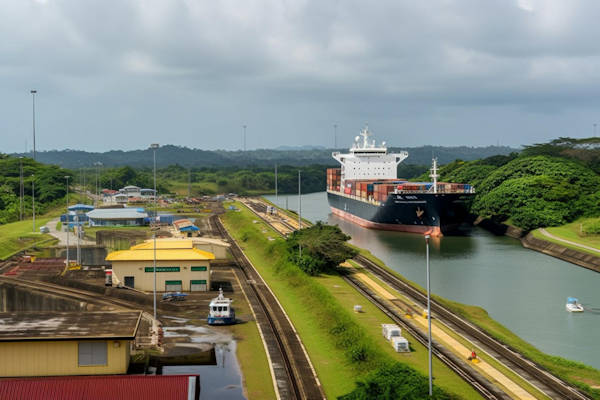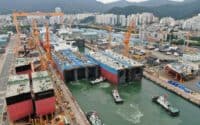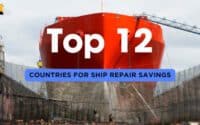Beyond Panama and Suez: Emerging Canals on the Maritime Horizon

As technological advancements have propelled us into the age of mega-ships, our existing canals are struggling to keep up. These massive vessels, often referred to as ‘Panamax’ or ‘New Panamax,’ are designed based on the maximum size specifications that the Panama Canal can accommodate after its expansion in 2016.
* Please send feedback/suggestions to editor @ shipuniverse.com
However, as shipping companies aim for economies of scale with even larger vessels, there’s a clear need for wider, deeper, and more accommodating canals. The current canals not only limit the size of the ships but also the volume of trade they can handle, potentially bottlenecking global trade.
The Ever-Growing Pulse of Global Trade
Globalization has woven countries tighter in the tapestry of trade. With populations booming and economies evolving, the demand for goods – and the need to transport them swiftly – has surged. Existing maritime routes, while efficient, are often congested. The pressure on major canals like the Suez and Panama is immense, leading to delays and, occasionally, disruptions as witnessed by the Suez Canal blockage. Thus, the call for new canals isn’t just about accommodating larger ships, but about facilitating the faster movement of an ever-increasing volume of goods.
The Climate’s New Doorways
Climate change is undeniably reshaping our world, and with the melting Arctic ice, new shipping routes are slowly unveiling. While the prospect of these routes offers shorter transit times between Asia, Europe, and North America, they also emphasize the potential need for new canals to better link emerging trade routes and ensure safe passage.
Major New Canal Projects: An Overview
The Nicaragua Canal: A New Channel for Global Trade
Background and Proposed Benefits:
Dreamed up as an alternative to the Panama Canal, the idea of a canal through Nicaragua is not new. Initial plans date back to the early 19th century, even before the Panama Canal was constructed. The Nicaragua Canal would connect the Caribbean Sea to the Pacific Ocean, providing another waterway for global shipping.
Proposed benefits of the Nicaragua Canal include:
- Capacity to Handle Larger Vessels: Unlike the Panama Canal, the Nicaragua Canal aims to accommodate even larger ships, further pushing the economies of scale in shipping.
- Increased Trade Volume: An additional canal would mean a higher capacity to handle global trade volume, reducing congestion and potential chokepoints.
- Economic Boost for Nicaragua: The canal’s construction and operation would create jobs, attract foreign investment, and stimulate economic growth for Nicaragua.
Current Status and Challenges:
Despite its potential benefits, the Nicaragua Canal project is mired in challenges:
- Environmental Concerns: Cutting a canal through Nicaragua would mean significant environmental disruptions, affecting freshwater resources, wildlife, and local ecosystems.
- Economic Viability: The cost of constructing such a canal is immense, leading to questions about its economic viability and return on investment.
- Geopolitical Tensions: The development of a new canal would alter global shipping dynamics, potentially creating tensions with other nations.
Arctic Shipping Routes: Navigating the Melting North
Impact of Global Warming and Melting Ice:
As global temperatures rise, the Arctic ice is melting at an alarming rate. This receding ice is gradually unveiling new maritime routes that were previously non-navigable.
Potential Benefits and Challenges of Arctic Shipping:
Benefits:
- Shorter Transit Times: Arctic routes can significantly reduce the distance between Asian, European, and North American markets, leading to quicker transit times and reduced fuel costs.
- Reduced Reliance on Traditional Canals: With additional routes, there’s lesser pressure on traditional chokepoints like the Suez and Panama Canals.
Challenges:
- Navigational Hazards: Despite the melting ice, the Arctic is still a perilous environment with floating icebergs, unpredictable weather, and limited search and rescue capabilities.
- Environmental Concerns: Increased shipping in the Arctic threatens its fragile ecosystem and poses risks of oil spills and other maritime accidents.
- Geopolitical Tensions: The Arctic is an arena of geopolitical contention, with several nations laying claim to its resources and routes.
Other Notable Proposals:
While the Nicaragua Canal and the Arctic shipping routes dominate discussions, several other canal proposals and early-stage discussions exist globally. For instance:
- Thailand’s Kra Canal: An idea that has been floated around for centuries, the Kra Canal would link the Andaman Sea to the Gulf of Thailand, providing a shortcut and alternative to the Strait of Malacca.
- Canal Istanbul: Turkey has proposed a new canal connecting the Black Sea to the Sea of Marmara, parallel to the Bosphorus, aiming to reduce traffic and risks in the busy strait.
These projects, like all major infrastructure developments, come with their own sets of advantages, challenges, and geopolitical implications.
The development of new canals and shipping routes is indicative of a dynamic global trade landscape. Each project presents its own opportunities and challenges, underlining the intricate balance between commerce, environment, and geopolitics.
Environmental Concerns
Potential Ecological Disruptions
Canal construction and operations pose considerable threats to local ecosystems. The act of cutting channels, dredging waterways, and the ongoing operations can lead to:
- Loss of Biodiversity: Displacing or endangering flora and fauna, some of which might be endemic to the region and thus irreplaceable.
- Water Contamination: The mixing of saltwater and freshwater can disrupt local aquatic systems, harming species that cannot tolerate the changes in salinity.
- Soil Degradation: Construction activities can erode soil and alter land topography, leading to potential landslides or loss of arable land.
Striking a Balance: Economic Growth vs. Environmental Sustainability
While canals promise significant economic growth, there’s an essential debate about the environmental costs associated. Canals can bring in revenue, boost trade, and create jobs, but they can also harm ecosystems, potentially leading to long-term environmental damage that could counteract short-term economic gains.
It’s crucial to assess whether the ecological harm can be justified by the economic benefits. This debate often centers on:
- Short-term vs. Long-term Impact: While economic benefits might be immediate, environmental damages can be long-lasting and sometimes irreversible.
- Direct vs. Indirect Benefits: Immediate economic gains might benefit a specific group, while environmental harms could affect broader communities and even future generations.
Mitigation Measures: Environment First
To offset the environmental impacts of canal development, several measures can be taken:
- Impact Assessments: Conduct thorough environmental impact studies before starting any construction to understand potential risks.
- Eco-friendly Construction Methods: Use modern techniques that cause minimal disruption, like silent piling.
- Restoration Efforts: Invest in restoring habitats that might be affected during construction.
- Continuous Monitoring: Even after construction, regularly monitor the ecological impact and adapt operations as needed to minimize harm.
Socio-Economic Impacts
Benefits to Host Nations
New canal projects can substantially boost the economy of host nations:
- Job Creation: From construction to operations to maintenance, canals can provide employment opportunities for thousands.
- Infrastructure Development: Canals often require the development of ancillary infrastructure, such as roads, ports, and railways, which can spur broader regional development.
- Trade Advantages: Canals can make a nation a pivotal trade hub, attracting businesses, investments, and increasing its geopolitical significance.
The Flip Side: Displacements and Socio-Cultural Changes
However, the development of massive infrastructure projects like canals can also have negative socio-economic implications:
- Displacement of Communities: Large-scale construction might necessitate relocating communities, causing loss of homes and ancestral lands.
- Socio-Cultural Impact: The influx of workers and new settlers can dilute local cultures or lead to social tensions.
- Land and Resource Rights: There can be disputes over land rights, especially if the areas are inhabited by indigenous or marginalized communities.
Alterations in Global Trade Dynamics
The introduction of a new canal or major shipping route can significantly alter global trade dynamics:
- Redistribution of Trade Traffic: Existing routes might see reduced traffic, impacting the economies that rely on them.
- Competitive Advantages: Nations with new canals can exert influence on global trade, potentially giving them a competitive edge in negotiations and alliances.
- Shift in Geopolitical Importance: New canals can shift geopolitical focus, making the host nations critical players on the global stage.
Geopolitical Implications
Shifting Power Dynamics and Conflict Potential
Canals aren’t just channels for water and trade; they’re also channels of power. The development of a new canal can significantly reshape global geopolitical landscapes:
- Regional Dominance: A nation controlling a major canal naturally attains a significant geopolitical advantage. It can influence trade routes, levy tariffs, or even block access during conflicts, thus wielding considerable power over global commerce.
- Potential for Conflicts: With increased significance, there’s also increased scrutiny. Rival nations might contest the control or access to a canal, potentially sparking regional tensions or even military confrontations.
Major Powers and Their Roles
Historically, major world powers have always been keenly interested in controlling pivotal trade routes:
- Funding and Development: Often, powerful nations invest in canal projects either directly or through international consortiums, looking to secure a stake in the canal’s future operations and benefits.
- Protection and Security: Major powers might also extend military or naval support to safeguard these canals, emphasizing their strategic importance.
- Diplomatic Maneuvering: The involvement of world powers in canal projects can lead to intricate diplomatic negotiations and treaties, sometimes resulting in shared control or guaranteed open access to ensure smooth global trade.
Securing and Policing New Routes
With the development of new canals comes the inherent responsibility of ensuring their security:
- Piracy Concerns: Major shipping routes can attract criminal elements. Efforts need to be made to deter piracy and ensure the safety of vessels.
- International Collaboration: Policing and securing major canals often require international cooperation, given their global significance. Naval patrols, joint exercises, and collaborative surveillance can be effective measures.
- Legal Frameworks: Clear legal guidelines need to be established regarding canal usage, tariffs, and conflict resolution to prevent misunderstandings and disputes.
Technological Advancements in Canal Construction
Modern Engineering and Feasible Ambitions
As engineering methods evolve, projects that were once deemed impossible are now within reach:
- Advanced Dredging: Modern dredging techniques allow for precise and efficient removal of underwater material, making canal construction faster and less environmentally damaging.
- Earthquake-Resilient Infrastructure: In seismically active zones, cutting-edge engineering ensures that canal structures remain resilient to earthquakes, reducing the risk of catastrophic failures.
AI and Automation: The Future of Canal Management
The era of smart canals is upon us:
- Predictive Maintenance: AI algorithms can analyze data to predict when parts of the canal, like locks or gates, might need maintenance, ensuring uninterrupted operations.
- Automated Traffic Management: AI-driven systems can optimize ship movement through canals, reducing waiting times and enhancing efficiency.
- Environmental Monitoring: Automation can play a pivotal role in continuous ecological monitoring, swiftly detecting and addressing any environmental disruptions.
Safety Innovations to Prevent Disruptions
The Suez Canal blockage highlighted the need for enhanced safety protocols:
- Advanced Navigation Systems: Incorporating state-of-the-art navigation tools to guide ships safely and efficiently through canals.
- Simulation Training: Using virtual reality and simulation tools, ship crews can be trained for canal transits, preparing them for potential challenges.
- Emergency Response Protocols: Establishing well-defined procedures and having specialized equipment on standby can ensure swift responses to incidents, minimizing disruptions.
Financing and Investment
The Immense Capital Needs of Canal Projects
Constructing a canal is no small feat, and the financial requirements reflect the magnitude of the endeavor:
- Initial Costs: This includes land acquisition, machinery, labor, and raw materials. It’s not just about digging a channel but creating supporting infrastructure like locks, dams, and ports.
- Maintenance Costs: Once operational, there are ongoing costs related to maintenance, personnel, security, and environmental preservation.
Embracing Public-Private Partnerships
Given the sheer scale of financing required, public-private partnerships (PPPs) have emerged as a preferred model:
- Risk Sharing: PPPs allow the distribution of financial and operational risks between governments and private entities.
- Pooling Resources: While governments provide land rights and regulatory clearances, private entities bring in capital, technology, and managerial expertise.
- Ensuring Efficiency: Private sector involvement can often lead to better management practices, ensuring the canal remains profitable and sustainable.
International Investments: A Global Stake in Canals
New canal projects often transcend national importance, capturing global attention:
- Multinational Investments: Major financial institutions, like the World Bank or Asian Infrastructure Investment Bank, often contribute due to the potential ripple effect of such projects on global trade.
- Foreign Direct Investment: Countries that stand to benefit from the canal might directly invest, anticipating future economic returns.
- Stakeholders Beyond Borders: Given the international nature of maritime trade, numerous nations become stakeholders, keenly watching, and often participating in, the project’s development and management.
Transforming Global Trade
New canals have the power to redefine maritime routes, influence the movement of goods, and subsequently reshape global economic landscapes. They are not just about facilitating trade but about propelling nations into strategic prominence.
Balanced, Sustainable, and Equitable Development
As we delve into the world of canal creation, there’s a pressing need to strike a delicate balance. Economic ambitions must be tempered with environmental caution. Local communities should benefit as much as global traders. Equity and sustainability must be at the core of every phase of development.
Peering into the Horizon: What’s Next?
While it’s challenging to predict the exact location or nature of the next big canal project, what’s certain is that human ambition knows no bounds. The demands of global trade, coupled with advancing technology, will keep pushing us to imagine, innovate, and invest. As history has shown, when there’s a will to change the map of global trade, there’s a way to carve a canal.
In the dance of global commerce, canals play an instrumental role. They remind us of human tenacity, the magic of engineering, and the intricacies of geopolitics. As we look ahead, the narrative of canals is set to evolve, promising exciting chapters in the story of global trade.
Additional Resource
- BBC
- Website: BBC News
- The BBC provides a wide array of global news, including topics on infrastructure and trade.
- Al Jazeera
- Website: Al Jazeera
- Al Jazeera is a Qatari-based international news outlet with comprehensive coverage on global topics.
- Reuters
- Website: Reuters
- Reuters offers international news, including detailed business and financial news.
- The Guardian
- Website: The Guardian
- The Guardian covers international news and often has in-depth articles on global development projects.
- National Geographic
- Website: National Geographic
- For environmental and scientific aspects of global developments, National Geographic is a reliable source.
- Foreign Affairs
- Website: Foreign Affairs
- For in-depth articles on global politics and policy, Foreign Affairs is a renowned source.
- Foreign Policy
- Website: Foreign Policy
- Another reputable source for geopolitical analyses and articles.
- The Diplomat
- Website: The Diplomat
- A publication focusing on the Asia-Pacific region, offering detailed analyses of geopolitical events.
- World Bank
- Website: World Bank
- The World Bank often releases reports and studies on global development projects, including infrastructure.
- Google Scholar
- Website: Google Scholar
- A platform to access academic papers and research on various topics.

Do you have a Maritime Product or Service that may be of interest to Shipowners? Tell us about it here!
Do you have feedback or insights? Please reach out to editor @ shipuniverse.com



